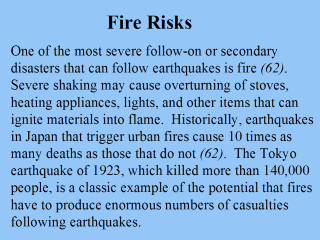| front |1 |2 |3 |4 |5 |6 |7 |8 |9 |10 |11 |12 |13 |14 |15 |16 |17 |18 |19 |20 |21 |22 |23 |24 |25 |26 |27 |28 |29 |30 |31 |32 |review |

|
Similarly, the large fire that
occurred after the 1906 San Francisco earthquake was responsible for much of the death
toll following that event. More recently, the 1994 Northridge earthquake in southern
California showed that strong vibrations may sever underground fuel lines or gas
connection points, causing spills of volatile or explosive mixtures and resultant fires (10,59).
Similarly, during the first 7 hours following the 1989 Loma Prieta earthquake in northern
California, San Francisco had 27 structural fires and more than 500 reported incidents of
fire (18). Furthermore, the city water supply was disrupted, significantly
impairing the city's ability to fight these fires (63). Perhaps the most vulnerable areas of all are the informal housing sectors on the periphery of many rapidly growing cities in developing countries (so-called "squatter housing" or "shanty town" settlements). Many of these have the potential for catastrophic conflagrations following an earthquake. |